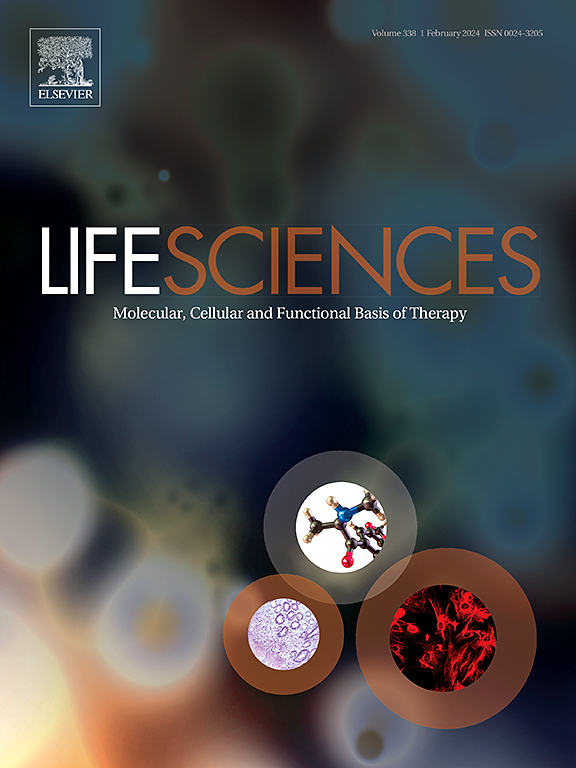Unravelling the roles of Vav3 in cytoskeletal control and angiogenesis
IF 5.2
2区 医学
Q1 MEDICINE, RESEARCH & EXPERIMENTAL
引用次数: 0
Abstract
The oncogene Vav guanine nucleotide exchange factor 3 (Vav3) can accelerate neovascularization in the context of cancer by increasing cell proliferation and metastasis, making it a useful reference for understanding the process of pannus development in rheumatoid arthritis (RA). The overactivation of synovial tissue leads to increased cell invasion and inflammatory infiltration, resulting in a tumour-like immune microenvironment. Pannus formation, an early complication of RA, can progress to bone injury. The regulatory effect of Vav3 on cell invasion mainly involves increased adhesion and metastasis to support neovascularization, with effects on inflammatory cells, osteoclasts, and the cytoskeleton, resulting in microvessel formation and even bone destruction. The influence of Vav3 on cell proliferation and differentiation manifests as the promotion of immune cell formation and activation, as well as the intensification of immune infiltration into the local tissue. Targeted inhibition of Vav3 expression can reduce the pathological damage described above and may be a potential therapeutic target to limit pannus formation. Notably, as Vav3 is a cytoskeleton-associated protein, the association between epigenetic modifications of Vav3 (such as methylation and acetylation) and metabolic reprogramming is an interesting direction for future research on autoimmune diseases. Therefore, we summarize the latest information related to the biological role of Vav3, emphasizing the regulatory effects of the cytoskeleton in pannus development in the context of tumour-related research and discussing the clinical value of Vav3 epigenetic modification and energy metabolism in angiogenesis.
揭示Vav3在细胞骨架控制和血管生成中的作用。
癌基因Vav鸟嘌呤核苷酸交换因子3 (Vav3)可通过促进细胞增殖和转移来加速肿瘤背景下的新生血管形成,为了解类风湿关节炎(RA)的血管形成过程提供了有益的参考。滑膜组织的过度激活导致细胞侵袭和炎症浸润增加,导致肿瘤样免疫微环境。腱鞘形成是类风湿性关节炎的早期并发症,可发展为骨损伤。Vav3对细胞侵袭的调节作用主要是通过增加黏附和转移来支持新生血管的形成,对炎症细胞、破骨细胞和细胞骨架产生作用,导致微血管形成甚至骨破坏。Vav3对细胞增殖和分化的影响表现为促进免疫细胞的形成和活化,增强免疫对局部组织的浸润。靶向抑制Vav3的表达可以减少上述病理损伤,可能是限制肠膜形成的潜在治疗靶点。值得注意的是,由于Vav3是一种细胞骨架相关蛋白,因此Vav3的表观遗传修饰(如甲基化和乙酰化)与代谢重编程之间的关联是未来自身免疫性疾病研究的一个有趣方向。因此,我们总结了Vav3的生物学作用的最新信息,在肿瘤相关研究的背景下强调细胞骨架在血管发育中的调节作用,并讨论了Vav3表观遗传修饰和能量代谢在血管生成中的临床价值。
本文章由计算机程序翻译,如有差异,请以英文原文为准。
求助全文
约1分钟内获得全文
求助全文
来源期刊

Life sciences
医学-药学
CiteScore
12.20
自引率
1.60%
发文量
841
审稿时长
6 months
期刊介绍:
Life Sciences is an international journal publishing articles that emphasize the molecular, cellular, and functional basis of therapy. The journal emphasizes the understanding of mechanism that is relevant to all aspects of human disease and translation to patients. All articles are rigorously reviewed.
The Journal favors publication of full-length papers where modern scientific technologies are used to explain molecular, cellular and physiological mechanisms. Articles that merely report observations are rarely accepted. Recommendations from the Declaration of Helsinki or NIH guidelines for care and use of laboratory animals must be adhered to. Articles should be written at a level accessible to readers who are non-specialists in the topic of the article themselves, but who are interested in the research. The Journal welcomes reviews on topics of wide interest to investigators in the life sciences. We particularly encourage submission of brief, focused reviews containing high-quality artwork and require the use of mechanistic summary diagrams.
 求助内容:
求助内容: 应助结果提醒方式:
应助结果提醒方式:


